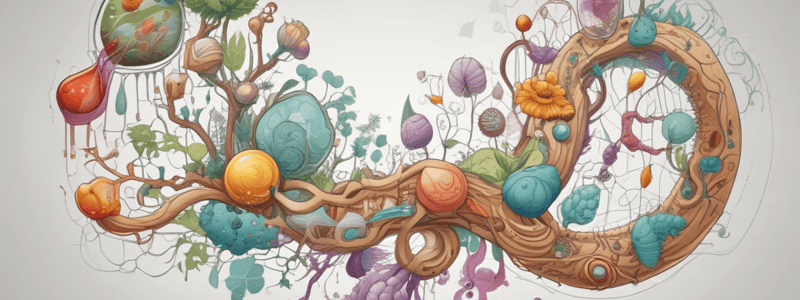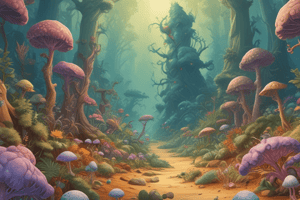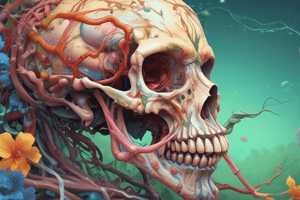Podcast
Questions and Answers
What is the study of the relationships between organisms and their environment?
What is the study of the relationships between organisms and their environment?
- Botany
- Ecology (correct)
- Microbiology
- Genetics
What is the basic structural and functional unit of life?
What is the basic structural and functional unit of life?
- Cells (correct)
- Molecules
- Organs
- Tissues
What is the process of cell division that results in two daughter cells with the same number of chromosomes as the parent cell?
What is the process of cell division that results in two daughter cells with the same number of chromosomes as the parent cell?
- Photosynthesis
- Meiosis
- Mitosis (correct)
- Respiration
What is the molecule that provides energy for cellular processes?
What is the molecule that provides energy for cellular processes?
What is the branch of biology that studies the structure and function of biological molecules?
What is the branch of biology that studies the structure and function of biological molecules?
What is the study of the chemical processes that occur within living organisms? change
What is the study of the chemical processes that occur within living organisms? change
Flashcards
Biology Definition
Biology Definition
The scientific study of life and living things, including their structure, function, evolution, distribution, and relationships with their environment.
Levels of Organization (Biology)
Levels of Organization (Biology)
Hierarchical arrangement of living things, from molecules to biosphere, showing increasing complexity.
Biological Molecules
Biological Molecules
Essential organic compounds in living organisms, including carbohydrates, proteins, nucleic acids, and lipids.
Cell Biology
Cell Biology
Signup and view all the flashcards
Ecology
Ecology
Signup and view all the flashcards
Mitosis
Mitosis
Signup and view all the flashcards
Study Notes
What is Biology?
- Biology is the scientific study of life and living organisms, encompassing a vast range of topics from molecular biology to ecosystem ecology.
- It examines the structure, function, growth, evolution, distribution, and taxonomy of all living things, including microorganisms, plants, animals, and humans, to understand the intricate relationships between them and their environments.
Branches of Biology
- Botany: study of plants and plant-like organisms
- Zoology: study of animals and animal-like organisms
- Microbiology: study of microorganisms, such as bacteria and viruses
- Ecology: study of the relationships between organisms and their environment
- Genetics: study of heredity, genes, and genetic variation
- Biochemistry: study of the chemical processes that occur within living organisms
- Molecular Biology: study of the structure and function of biological molecules, such as DNA and proteins
Levels of Organization
- Molecules: basic building blocks of life, such as carbohydrates, proteins, and nucleic acids
- Cells: basic structural and functional units of life
- Tissues: groups of similar cells that perform a specific function
- Organs: structures composed of two or more types of tissues that work together to perform a specific function
- Organ Systems: groups of organs that work together to perform a specific function
- Organism: individual living thing, such as a plant or animal
- Population: group of organisms of the same species living in a specific area
- Community: group of different species living in a specific area
- Ecosystem: group of living and non-living components that interact in a specific area
- Biosphere: all of the ecosystems on Earth
Biological Molecules
- Carbohydrates: provide energy and structure for organisms
- Proteins: perform a variety of functions, such as catalyzing reactions and replicating DNA
- Nucleic Acids: contain the genetic information necessary for life
- Lipids: provide energy and structure for organisms
- ATP: molecule that provides energy for cellular processes
Cell Biology
- Cell Membrane: thin layer of lipid and protein molecules that surrounds the cell
- Cytoplasm: jelly-like substance inside the cell membrane where metabolic processes occur
- Nucleus: contains the cell's genetic material
- Mitosis: process of cell division that results in two daughter cells with the same number of chromosomes as the parent cell
- Meiosis: process of cell division that results in four daughter cells with half the number of chromosomes as the parent cell
What is Biology?
- Biology is the scientific study of life and living organisms, examining their structure, function, growth, evolution, distribution, and taxonomy.
Branches of Biology
- Botany is the study of plants and plant-like organisms.
- Zoology is the study of animals and animal-like organisms.
- Microbiology is the study of microorganisms, such as bacteria and viruses.
- Ecology is the study of the relationships between organisms and their environment.
- Genetics is the study of heredity, genes, and genetic variation.
- Biochemistry is the study of the chemical processes that occur within living organisms.
- Molecular Biology is the study of the structure and function of biological molecules, such as DNA and proteins.
Levels of Organization
- Molecules are the basic building blocks of life, including carbohydrates, proteins, and nucleic acids.
- Cells are the basic structural and functional units of life.
- Tissues are groups of similar cells that perform a specific function.
- Organs are structures composed of two or more types of tissues that work together to perform a specific function.
- Organ Systems are groups of organs that work together to perform a specific function.
- Organism is an individual living thing, such as a plant or animal.
- Population is a group of organisms of the same species living in a specific area.
- Community is a group of different species living in a specific area.
- Ecosystem is a group of living and non-living components that interact in a specific area.
- Biosphere is all of the ecosystems on Earth.
Biological Molecules
- Carbohydrates provide energy and structure for organisms.
- Proteins perform a variety of functions, such as catalyzing reactions and replicating DNA.
- Nucleic Acids contain the genetic information necessary for life.
- Lipids provide energy and structure for organisms.
- ATP is a molecule that provides energy for cellular processes.
Cell Biology
- Cell Membrane is a thin layer of lipid and protein molecules that surrounds the cell.
- Cytoplasm is a jelly-like substance inside the cell membrane where metabolic processes occur.
- Nucleus contains the cell's genetic material.
- Mitosis is the process of cell division that results in two daughter cells with the same number of chromosomes as the parent cell.
- Meiosis is the process of cell division that results in four daughter cells with half the number of chromosomes as the parent cell.
Studying That Suits You
Use AI to generate personalized quizzes and flashcards to suit your learning preferences.




